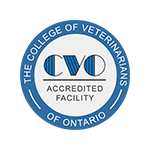Educational Articles
-
Ataxia means incoordination within the nervous system. There are several forms of ataxia, depending upon where in the nervous system the abnormality occurs. The most common sign of ataxia is an abnormal, unsteady gait. Treatment of ataxia will be influenced by the root cause. Pain management, supportive care (such as anti-nausea medication), and creating a safe environment (e.g., preventing access to stairs) are cornerstones of ataxia treatment.
-
Ataxia means incoordination within the nervous system. There are several forms of ataxia, depending upon where in the nervous system the abnormality occurs. The most common sign of ataxia is an abnormal, unsteady gait. Treatment of ataxia will be influenced by the root cause. Pain management, supportive care (such as anti-nausea medications), and creating a safe environment (e.g., preventing access to stairs) are cornerstones of ataxia treatment.
-
This handout summarizes atlantoaxial (AA) luxation, a condition in which instability or excessive movement is present between the first two vertebrae within the neck. Atlantoaxial luxation can be caused by trauma, hereditary factors, or a combination of these two factors. The most common sign of AA luxation is neck pain, though severely affected dogs may lose their ability to breathe due to paralysis of the diaphragm.
-
This handout discusses atopic dermatitis (atopy), a form of allergic skin disease brought on by an abnormal response to allergens in the environment. The clinical signs, diagnosis, and treatment are outlined.
-
This handout explains atopic dermatitis (atopy) in dogs, a form of allergic skin disease brought on by an abnormal response to allergens in the environment. The clinical signs, diagnosis, and treatment are outlined.
-
Atrial fibrillation describes very rapid contractions or twitching of the heart muscle, specifically in the atria. Most of the time, atrial fibrillation in cats occurs secondary to heart disease. Sometimes, in large breed cats, atrial fibrillation will occur as a primary heart problem. Most cats who develop atrial fibrillation have underlying heart disease, so the signs that are observed are often related to that underlying condition, and may include exercise intolerance, cough, or difficulty breathing. Treatment varies depending on whether the pet has primary or secondary atrial fibrillation. Your cat will need to be monitored on a regular basis.
-
Atrial fibrillation describes very rapid contractions or twitching of the heart muscle, specifically in the atria. Most of the time, atrial fibrillation in dogs occurs secondary to heart disease. In some large breed dogs, atrial fibrillation occurs as a primary heart problem. Most dogs who develop atrial fibrillation have underlying heart disease, so the signs that are observed are related to that disease and may include exercise intolerance, cough, or difficulty breathing. Treatment varies depending on whether the dog has primary or secondary atrial fibrillation. Your dog will need to be monitored on a regular basis.
-
Atrioventricular (AV) valve dysplasia is a developmental malformation of the mitral or tricuspid valve in the heart. Signs include exercise intolerance, accumulation of fluid in the abdomen, weight loss, and stunted growth. Difficulty breathing or collapse may occur if congestive heart failure develops. Treatment of AV valve dysplasia is focused on managing signs of congestive heart failure and/or disturbances in heart rhythm, generally using medications.
-
Atrioventricular (AV) valve dysplasia is a developmental malformation of the mitral or tricuspid valve in the heart. Signs include exercise intolerance, accumulation of fluid in the abdomen, weight loss, and stunted growth. Difficulty breathing or collapse may occur if congestive heart failure develops. Treatment of AV valve dysplasia is focused on managing signs of congestive heart failure and/or disturbances in heart rhythm, generally using medications.
-
AIHA or IMHA is a life-threatening condition that may occur as a primary condition or secondary to another disease. Most cats with AIHA have severe anemia and their gums will be very pale. They will be anorexic, listless, easily tired, and will have increased heart and respiration rates. Diagnosis involves a complete blood count (CBC), biochemical profiles, urinalysis, and X-rays or ultrasound of the abdomen and chest. Treatment may involve blood transfusions and other medications over a prolonged time. The prognosis may be better if an underlying cause can be identified.




